#milkweed seed pods
Explore tagged Tumblr posts
Text
today i found a plant growing in an alleyway downtown that gave me this delightful little seed pod that looks like a little banana about an inch long but it splits down the front to reveal hundreds of flat little seeds with little papery wings seed wings and theyre all stuffed into neat rows in a way that makes the pod look like an overfull expanding file and if you run your finger over it seeds fall out. the plant had like 6 of them going overhanging this one sidewalk and some of them were huge, like multiple inches long. anyway plants are still just making stuff outside it seems
#seedposting#this pod fell off into my hand when i touched it so i was like oh for me??? the fruits of nature???#also the reason why this strikes me is bc we have multiple milkweed species around here that do a pod thing#but with big floofs on the end of each seed. and those look less like an expanding file and more like a tissue box#but there arent a whole lot of plants around here that have the little papery seed wings inside a pod??#and the size. the whimsy#im assuming its an ornamental bc i havent seen it around here before lmao
1K notes
·
View notes
Text

#Nature#Nature Photography#Macro Photography#Autumn Vibes#Seed Pods#Milkweed#Pollinator Plants#Colorado Nature#Wild Plants#MissedMileMarkers
28 notes
·
View notes
Text
Collecting Milkweed Seeds - All Facts, All Seeds, No Fluff
(OK but please also consider I'm not an ~expert~ I'm not a ~scholar~ I'm just a nerd on Tumblr who really likes milkweed and wanted to make a fun lil post about it)
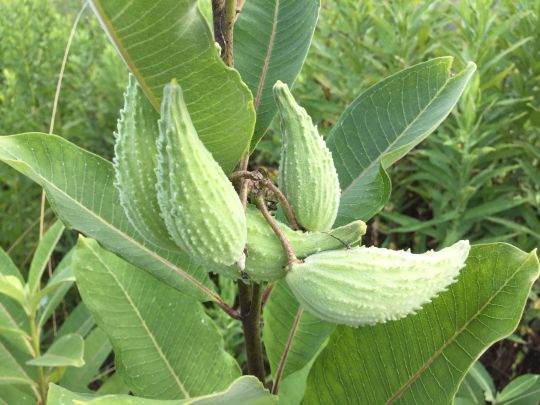
[Image ID: a green, leafy common milkweed plant (Asclepias syriaca) with five large, ovalish and bumpy green seed pods. The seed pods are currently unopened.]
It’s fall, which means if you haven’t seen them already, now’s the time that milkweed plants will start producing seed pods! (Well, technically, they’re called follicles, but fuck it they’re seed pods). Each pod has dozens of seeds inside, some species can even have up to 200 seeds, so even collecting just a few can be a good way to boost your pollinator gardening efforts big time! What you do with them then is up to you--adding life to your backyard garden, sharing with friends, making seed bombs--but first you’ve gotta collect them.
The first thing you want to do is identify your milkweed plants--in an ideal world, you’d be able to tell precisely what kind of milkweed you’re collecting from (so you can know precisely what growing conditions that species prefers.) But when they’re dying back, forming pods, and releasing their seeds, it can be hard to tell. It helps to visit sites early, to know what milkweeds are there, and while you’re there you might even find some forming pods.
It can be helpful to band off the pods early! This will keep the seeds from escaping, so you can come back later and collect them! I would only do this for a couple of pods--each pod has a lot of seed in it, so only taking one or two from each plant should still net you plenty of rewards! When I’m doing this in my backyard, I tend to use rubber bands--the size of rubber band you’ll need varies depending on the species. I’ve also seen people use the lacy-looking jewelry bags to a similar effect--if the pod splits open, all the seeds get trapped in the bag!

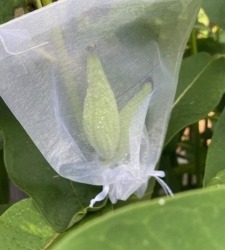
[Image ID: the first image is of appears to be swamp milkweed (Asclepias incarnata) with about fifteen long, green, smooth and pointed seed pods. Most of the pods have small black rubber bands wrapped around the midsections. The second image is of what appears to be common milkweed (Asclepias syriaca) with two large, ovalish and bumpy green seed pods. A white fine mesh bag has been tied over the pods.]
For people who want to get seeds from unopened pods, you have to be very careful not to force open a pod that isn’t ready--otherwise, the seeds inside won’t fully develop. How do you tell if a pod is ripe? There’s a seam in each pod, and it should open fairly easily with minimal pressure if it’s basically ready. If you’re basically prying it open, you’re too early. The seeds inside should be a nice dark color, and be plump in the middle--if they’re creamy colored or light orange, you’re too early. There may be some undeveloped seeds in each pod (I am talking maybe 1 to 3 here), but if the majority of them are ready, you’re good to go!

[Image ID: a tropical milkweed (Asclepias curassavica) seed pod that has been opened at the seam, revealing dark brown seeds and lots of creamy white floss. Four seeds are floating away from the pod on fluffy white comas. The pod is being held between a white person's fingers.]
I’ve also seen people who go late late late into the season, after most of the pods have already fully split off and released their seeds. Some of the seeds occasionally stay in the pod, so they’ll take the leftovers that didn’t get scattered after winter passes. That’s a fair strategy! I prefer to get mine way early on, so I can get a clear ID of what kind of milkweed it is (some will flower and produce pods at the same time), but if you already got an ID early in the season and then come back later this can also work! But…

[Image ID: several dried brown seed pods have opened fully, releasing a cloud of milkweed floss with seeds attached. Some seeds are still in the pods, but many are primed to float away.]
There is, however, one thing that tends to be a bit annoying about collecting milkweed seeds--and that’s the fluff. These fluffy white bits attached to the seed--called comas--function similarly to the iconic fluffy dandelion seed. A milkweed seed’s coma allows it to float through the air and on the water until it (hypothetically) reaches bare soil or an otherwise suitable start to settle down and germinate. If you’re collecting the seeds for later use, though, that same coma can mean your milkweed seeds are traveling through the air and away from where you’re collecting them, or all over your apartment once you get them home. Removing the comas by hand is an option, but tedious, and still leads to a nice pile of fluffy that will get airborne at the first gust of wind. At the end of the day, for many people trying to collect milkweed seeds, the coma is just an annoying part they dread.
Fortunately, there are plenty of ways to collect milkweed seeds without having to deal with the comas long-term!
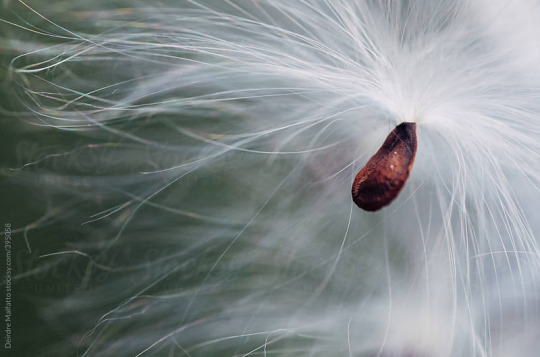
[Image ID: A single brown milkweed seed floating on a comparatively huge mess of white fibers.]
Method 1
So this is my favorite method because it's honestly one of the simplest and easiest once you get used to it. You open the pod, grip the top part of the middle ‘pith’ section tight, and gently scrape off the seeds into a bowl or bag. This leaves you with almost no fluff in your collection bin, and you can then toss the middle fluffy part--or I’ve heard of people collecting milkweed fluff for spinning! Most of the videos I’ve seen on it use common milkweed or other large milkweed pods as an example--however, I’ve successfully done this with smaller milkweed pods like A. curassavica as well.
youtube
Method 2
This method is one I’ve used in the past. Take the seeds and fluff and put them into a bag (paper or plastic) and add a coin or two. Shake the bag around--a lot. The coin will dislodge the comas from the seeds. The seeds will then drop to the bottom of the container, and the fluff will float around on the top. I’ve also seen this with buckets and blocks, like in the video below!
Method 3
I’ve seen a handful of people discuss burning the floss of the seeds! Apparently the seeds themselves aren’t damaged badly by the fire, though honestly this is a method that I am simply too anxious to try myself.
youtube
Method 4
This was a method I found while I was looking for other methods people have done. Apparently, you can just roll the pod between your hands and it’ll work to dislodge the seeds? I may have to try it next time!
youtube
Hopefully this advice is helpful for you all! I know collecting seeds was a hassle for me before I learned my favorite method. If I had a nickel for every time I got yelled at for releasing milkweed fluff into the house...
If you've got a method that I haven't heard about yet, let me know!! I'm always down to learn more about milkweed, and it can also help someone else down the line!
#milkweed#asclepias#seed saving#seed collecting#pollinator garden#outdoor gardening#gardening#flowers#ani rambles#out of queue#i think this was my first time doing image descriptions??? if they suck ass let me know and I'll Make Adjustments As Recommended#i've seen people talk about spinning the milkweed floss??? but I saw online that it was too brittle to be spun????#but either way if you wanna save the floss and do Stuff with it go for it#did you know. or actually this is me functioning from memory.#but if I recall correctly I believe in either the WWI era or the WWII era#people would pay kids to go around fields collecting milkweed seed pods and pay them by the pound#and then they'd take the floss and use it to fill life jackets for soldiers?#i think this was less of a 'extorted child labor sweat shop' deal and more of a like#'hey kids wanna earn some cash and also be a Patriotic Citizen? go find some seed pods and we'll give you money'#which i guess many people WOULD consider an Extorted Child Labor kinda deal but like#idk seems like a chill deal to me#anyways hope you guys like this post#Youtube
190 notes
·
View notes
Text


Milkweed is starting to come up :)
#cant wait to try cooking a few seed pods i have read theyre very good#if they grow before im outta here that is#hope so#otherwise i will have to sneak back in the dead of night and steal a few#which sounds like a lot of effort#milkweed
36 notes
·
View notes
Text

Ready to Fly
Milkweed seeds releasing from pod.
By Joe VDB
24 notes
·
View notes
Text


Hell yeah hell yeah hell yeah
More milkweed more milkweed
The wasps are guarding them
My partner tried to mow them down, but got swarmed by wasps, and had to flee indoors.
#i gave the wasps a plate of sugar water and watermelon pulp#as a treat#i want to turn the entire fenced backyard into wildflowers#mostly milkweed#Longfeather Lane#personal#milkweed#plants#can't WAIT for those seed pods to be ready
47 notes
·
View notes
Text

kaijune day 1: seed
lets see how far i get in this one
12 notes
·
View notes
Text






Green Antelopehorns milkweed, pods and seeds, leftover fuzz for nesting materials.

Green Antelopehorns milkweed Flowers from early spring.
#milkweed#Green Antelopehorns milkweed#seeds#seed pod#flower#green flowers#fuzz#harvest#nature#nature photography#collecting seeds#monarch#caterpillar food#growing my own#butterfly host plant#my photography#photography#photographers on tumblr#flowers#texas#Gun Barrel City Texas#East Texas#Cedar Creek Lake#save the monarchs#monarch butterfly#host plant
19 notes
·
View notes
Text
Yesterday I volunteered at a pollinator event and I got a free plant! It was a pale purple coneflower, a native species I had been having a hard time getting my hands on! And it was a lovely sized plant, not a seed or even a seedling!
I'd been neglecting my garden lately but that day the weather was supposed to be nice for a bit until some rain. So I grabbed my gloves and went out, intending to just clear a bit of crabgrass out of my native perennial bed to make a spot for the new plant.
I came back to consciousness two hours later.
I stopped when I felt the first raindrop. I had worn open blisters into two fingers, other fingertips had blisters so bad I could barely type, and my forearms were scratched to shit from crabgrass and fescue. I'd cleared out about three quarters of the weeds in the bed and also expanded it by six inches all around by pulling more grass and moving the edging stones.
holy shit
ow
my garden actually grew in nicely under all the shit i let fester
#my posts#yayyyy adhd and avoidance until hyperfixation#all three of my tiny wisps of butterfly milkweed survived!#one is still a bit of a tiny wisp#but the other two are pretty substantial!#my yarrow is going GREAT#my black eyed susans are doing GREAT#i havent gone super deep into my rue or coneflowers or phlox#but i can tell my rue survived pretty well!#when i cut the garden back i'll save some to dry#i have a friend who really wants to try some roman cooking with it#id also bought a couple of fully grown butterfly milkweed plants#and one of them is now COVERED in seed pods#im gonna harvest those and get as many to grow as I can#maybe next year or the year after i have a hedge of butterfly milkweed :)
27 notes
·
View notes
Text

Orbea variegata seed pod time
#the Huernias have never made pods (that I've seen) nor has the one Stapelia we have. but these apparently self-pollinate easy or smth.#wild. they look so dang goofy too. hey man ✌#they end up with milkweed tuft sorta seeds. bc... they are cousins! plants are silly.
6 notes
·
View notes
Photo

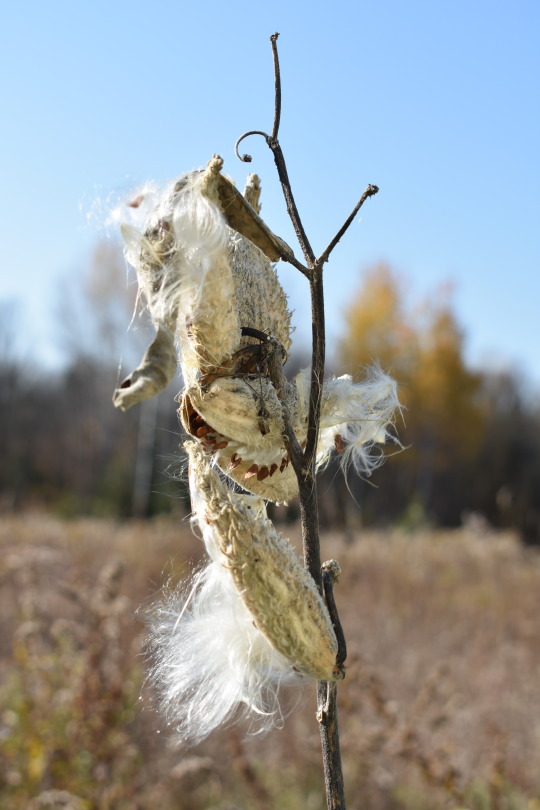
Common Milkweed Asclepias syriaca Apocynaceae
Photographs taken on October 22, 2022, at Marmora and Lake, Ontario, Canada.
#wildflowers of southern ontario#Common Milkweed#milkweed#Asclepias syriaca#seed pod#Apocynaceae#Asclepias#Marmora and Lake#Ontario#Canada#Marmora
17 notes
·
View notes
Text
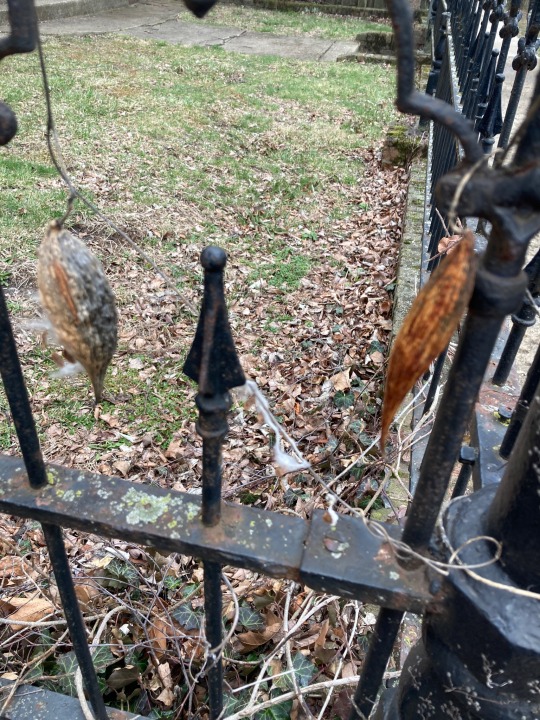
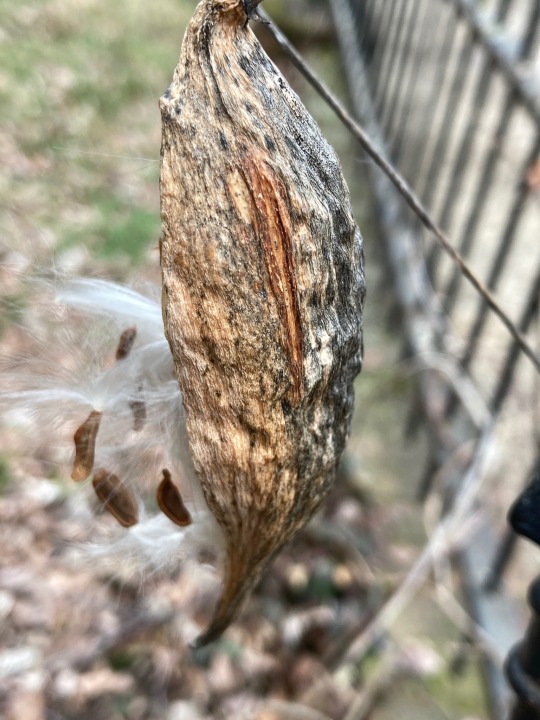
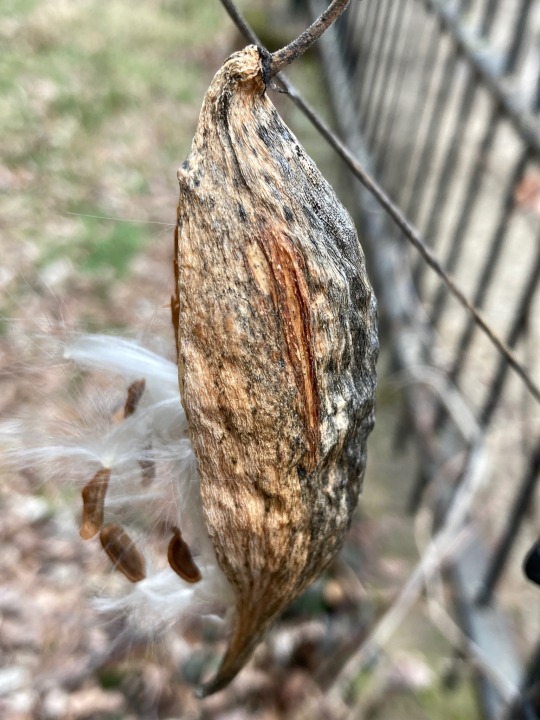

#honey vine climbing milkweed#swallowwort#cynanchum laeve#seed pods#seed clocks#urban nature#columbus#ohio
9 notes
·
View notes
Photo

by Elizabeth Johnson-Wold
3 notes
·
View notes
Text

This little sample is 100% milkweed silk. I'm using a very small--albeit not very light--supported spindle. I just wanted to try out this tiny art spindle I carved like months ago. It's a little shorter than a sharpie, works great, probably will work even better when the tips of my thumbs aren't super bruised from the whittling (has been long enough the callouses were gone). Might also try with my wheel at some point although it sounds like a nightmare to me. I don't have any cotton spinning tools, so supported spindles are probably the best for now.
Problem mostly is that it's very similar to spinning cotton, because ive never been any good at spinning cotton. So I might need to practice cotton instead, as I have more of it.
But this is a small sample of two ply (with a wool single as a leader). I tried spinning it with variable amounts of twist--it didn't tolerate a ton before snapping, but held together fine at a medium twist. I don't know about strength yet. But it's so soft and glittery and warm--just holding it in the fingertips makes it hot. It's pretty fantastic at the moment. We'll see how it ages.
#still not brittle. maybe as it dries out it gets brittle we'll see. because it kept snapping with high twist i cant imagine it would make#like. a rope ? or even an everyday yarn#but thats what the bast fibers are for anyway#wonder if i can blend the milkweed tow with some silk ?#anyway ill also try this with the floss once its old enough. am pulling off damaged green seed pods so they dont rot#milkweed#showy milkweed
131 notes
·
View notes
Text
Thought I lost some new plants to the drought because I couldn’t water them enough without just leaving the hose running for hours.
Turns out they just went dormant and have since revived now that we’ve gotten regular rainfall.
#I could just leave the hose running since we have a well but I don’t like to#cut the comfrey down to mulch the garage side garden area#the hollyhock is not tall but it’s blooming#milkweed is blooming and New Jersey tea is blooming and they smell nice#columbine seed pods are opening so I gave them a shake to spread more in front garden
0 notes

